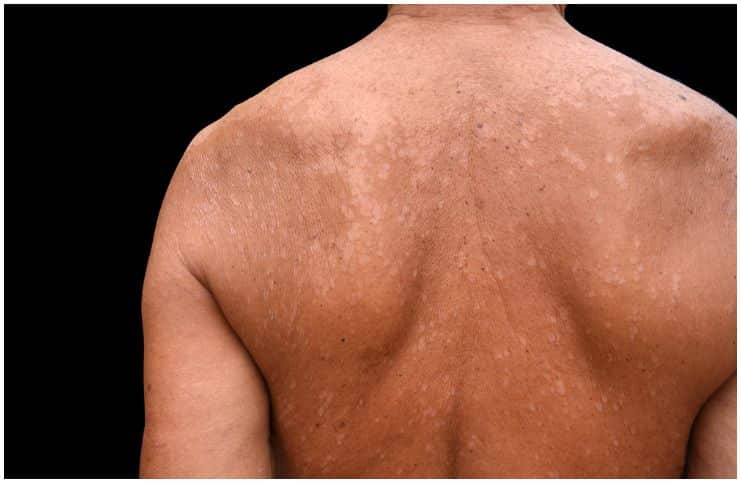Tinea versicolor, also referred to as pityriasis versicolor, is a fungal infection of the skin. This condition was first identified in 1846.
The medical term ”versicolor” refers to the fact that this skin condition causes the affected skin to become either darker or lighter than the surrounding skin.
It affects people of any skin color. However, it is more likely to affect teenagers and young adults and is one of the most frequent skin diseases in subtropical and tropical areas of the world. This condition usually clears in the winter months but it can recur each summer.
The areas most usually affected by this skin condition include the neck, chest, tummy, back, and upper arms. It produces a substance which usually leads to the bleaching of the skin and pale patches, even after treatment. The skin may not regain its usual pigmentation even following a few years after the infection is gone.
Symptoms
- scaling
- mild itching of the affected area
- patches of skin discoloration, commonly on the chest, back, upper arms, and neck, that may appear darker or lighter than usual. These patches are frequently flat, without texture, but may flake. Each sufferer will generally have only one of the colors.
Causes
It occurs when a type of yeast from the Malassezia family causes an infection on the skin. This fungus lives naturally on the skin and can multiply in a yeast-like fashion. Also, this type of yeast is the cause of a few other skin conditions, such as – psoriasis and dandruff.
Furthermore, this skin problem may be triggered by oily skin, excessive sweating, or a weakened immune system.
Things that can weaken your immune system include – bad nutrition (especially a diet that contains hormones, trans-fats, food additives, or processed foods), taking prescription medicines which suppress the immune system, poor sleeping habits, sedentarism, lack of vitamin D, chronic stress, or some types of cancer.
Some sufferers may be genetically predisposed to overgrowth of this type of yeast. Also, hormonal fluctuations, such as menstruation, can promote the multiplying of this yeast.
Poor hygiene is not related to this condition at all, however, pityriasis versicolor may chronically recur in some people with a predisposition.
Diagnosis
It may be diagnosed by a KOH preparation and lesions may fluoresce copper-orange when unveiled by an ultraviolet light.
Prevention
You may use an anti-dandruff shampoo on the skin every month to help prevent this condition. Also, it is recommended to avoid excessive heat if you have had this skin problem in the past.
Tinea Versicolor Natural Remedy
#1 Coconut Oil
It is made up of 3 different medium-chain fatty acids – capric acid, caprylic acid, and lauric acid, which have fungus-killing properties.
Note – before buying coconut oil, be sure to purchase an organic, pure coconut oil. Also, when a yeast infection appears on the surface of your skin, this oil can be applied in a similar way as a prescription cream.
#2 Tea Tree Oil
Tea tree, also referred as melaleuca, is renowned for its ability to treat wounds as it has strong antiseptic properties. Tea tree oil is an effective natural home treatment for pityriasis versicolor due to its potent anti-fungal properties.
Note – while tea tree oil is commonly considered one of the safest oils for undiluted topical use on skin, it is recommended for people with sensitive skin to dilute it with a carrier oil. If you apply it to your skin, stay out of the sun (or cover that skin area) since this essential oil can make you more sensitive to ultraviolet rays.
#3 Aloe Vera
It is considered to be a miracle plant due to its many healing and curative benefits. This medicinal plant is an effective treatment for this skin condition because of its capacity to stop the spreading of Malassezia globosa fungus.
Aloe vera is also used to relieve irritation and itching since it contains glycoproteins that help lower inflammation levels. It can be applied topically on the affected area, or you can use it in a gel form with aloe vera.
#4 Cinnamon
It is thought to be a ground spice, but actually, cinnamon comes from a tree. In the present day, it is grown in numerous parts of the world, especially in China, Vietnam, Sri Lanka, and Madagascar.
Research shows that cinnamon has strong antifungal properties. Also, this spice can regulate glycemia levels, hence, preventing blood sugar spikes. It is a known fact that regular blood sugar spikes may lead to a fungus overgrowth.
#5 Garlic
Many studies have concluded that garlic has potent antifungal properties. Not only that, garlic is an active detoxifier and a proven immune-booster. Also, a regular intake of garlic can lower LDL and total cholesterol levels.
Tinea Versicolor Diet
The best diet for this condition is a diet that boosts the immune system. First, you should eliminate all artificial sweeteners, processed meats, eggs, dairy products, caffeine, alcohol, and vegetable oils. Second, focus on foods high in vitamin C.
These foods include – pineapple, guavas, turnips, spinach, acerola, Brussels sprouts, green peppers, red pepper, tamarinds, cayenne peppers, kiwi, kale, currants, basil, cauliflower, persimmons, papayas, bananas, pears, radishes, sweet potatoes, blackberries, carrots, broccoli, banana pepper, parsley, oranges, chestnuts, papayas, strawberries, cabbage, apples, grapefruit, clementines, peas, and mangoes.
Watch this video below for more foods good for the skin.
Image credit – Shutterstock
READ MORE: Famous People With Acromegaly
